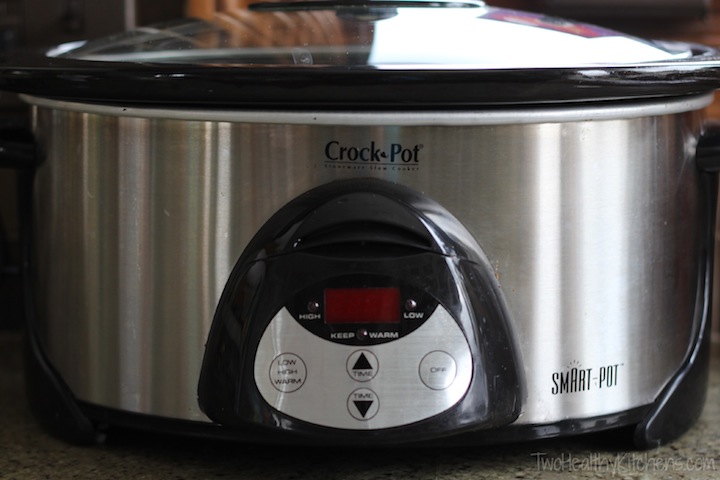
With so many people using their crock-pot slow cookers as mega time-savers, this question is a surprisingly hot topic out there on the Internet:
Can you put frozen meat in the crock-pot?
Our short answer … DON’T DO IT!
For those of you craving a little more detailed explanation, here’s the scoop …
We’ve read a lot of buzz about this issue, and even fielded a great question about it from a reader back on our post for 3-Ingredient Crock-Pot Chicken Tacos. So, we know there’s tremendous confusion and debate surrounding this topic, and we wanted to try to clear up some misconceptions and help direct you to safe, reliable information sources.
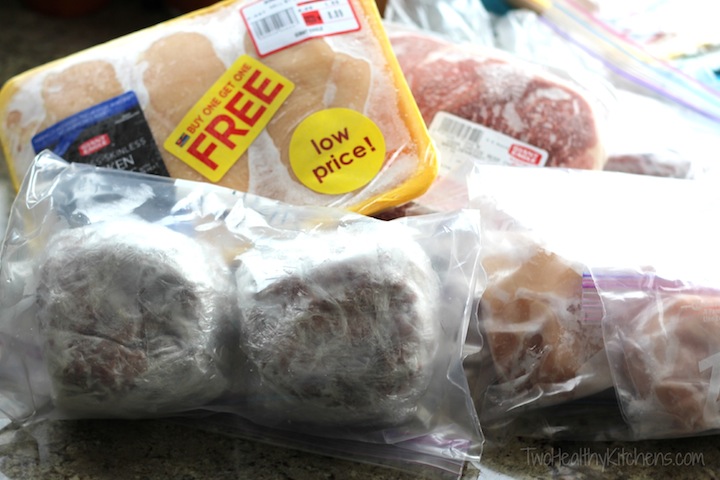
There are really two questions here: 1) Can a crock-pot cook meat from a frozen state? and 2) Should you cook meat this way?
If you’re like us, then you no doubt have heard people say that it’s perfectly ok to put stone-cold frozen meat directly into the crock-pot. Maybe you’ve even tried it (and lived to tell the tale!). You can certainly find a shockingly large amount of recipes online that call for frozen meat in slow cooker recipes.
So, yes … a crock-pot can cook frozen meat. It will work.
That’s really not the point, though.
The real issue is whether cooking frozen meat in the crock-pot is safe. Reputable cooking sites, cookbooks and food safety resources agree that it’s not a good idea. No matter how many people tell you they’ve done it without a problem, we still urge you not to try it.
For us, it’s just not worth the risk.
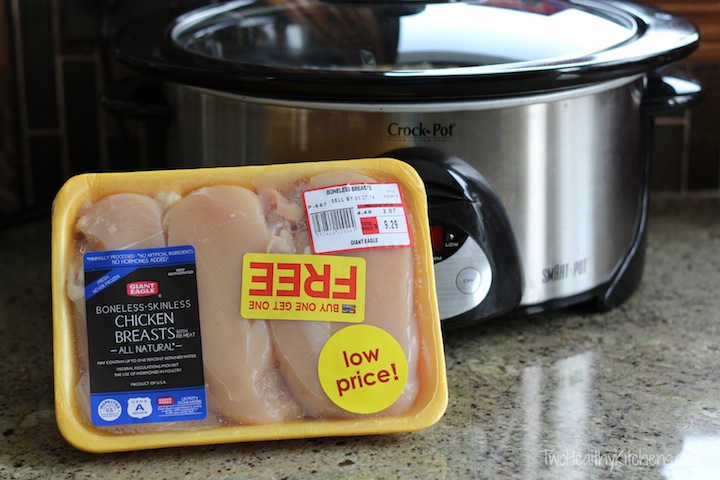
Why? Because slow cookers don’t reliably get frozen meat up to a safe temperature (above 140°F) evenly enough or quickly enough. Your meat will likely spend too much time hovering in the danger zone (from 40°F – 140°F), which opens the door for bacteria to flourish. Not yummy … or safe!
This can be a particular problem for people who are considered at higher risk for food-borne illnesses: older people, pregnant women, little kiddos, and people with challenged immune systems (groups which we’ve seen estimated as comprising approximately 20% of the population).
There are numerous issues that you may see people debating in online chats, which they feel can affect how quickly a crock-pot cooks frozen meat: what heat setting you’re using, how old your slow cooker is, what model it is, how big it is, how full your crock-pot is for any given recipe, what the temperature of the other ingredients is when you start cooking, how much liquid is in a recipe … you get the idea. There are way too many variables. And the bottom line is that there’s just no guarantee whatsoever that your recipe will turn out to be both delicious and safe to eat.
We’re not willing to take that risk with our families, and we certainly don’t advise you to take the gamble with your own loved ones.
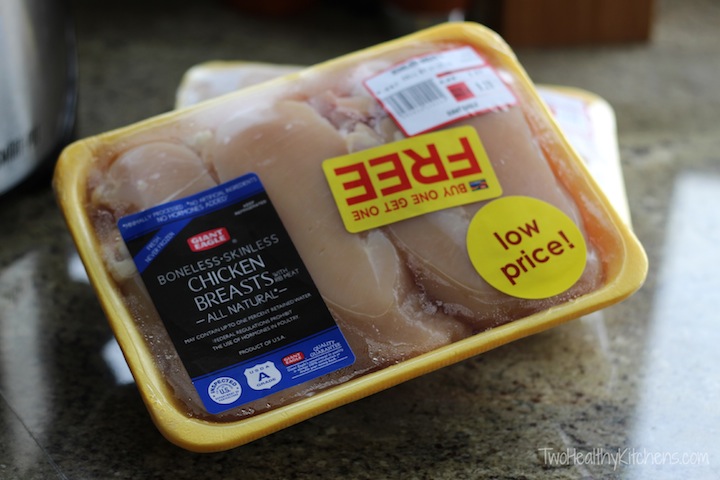
Instead, thaw your meat over a day or two in the temperature-safe zone of your refrigerator. Or, if you didn’t plan far enough ahead (egads – we’ve been there!), use your microwave’s defrost setting to gently thaw your meat (check it and rotate it to avoid cooking some parts while others remain frozen), and then immediately transfer it to your crock-pot to get it cooking and rapidly up to a safe temperature.
That tiny little bit of extra effort can save you and your family from a miserable bout of food poisoning. We think that’s well worth it!
Now, we know there will be plenty of you who swear you’ve used frozen meat for years with no problem. (Remember – we said this is quite the hotbed of debate, and we’re expecting plenty of controversy.) But after Gretchen’s food safety courses in her master’s program, and Shelley’s experience in professional and cooking school kitchens, plus all of our research, it’s our firm conviction that you’re taking an unnecessary and avoidable risk. That’s why all of our slow cooker recipes call for starting with fresh or thawed meats, and we just want you to be fully educated about the issue.
If you’d like to read more, check out these resources:
• Better Homes and Gardens Year-Round Slow Cooker Recipes by Better Homes and Gardens
• Slow Cooker Revolution Volume 2 by the Editors at America’s Test Kitchen
• American Heart Association Healthy Slow Cooker Cookbook by the American Heart Association
• Betty Crocker’s Slow Cooker Cookbook by Betty Crocker
• Cooking Light Slow-Cooker Tonight! by the Editors of Cooking Light
• USDA Food Safety and Inspection Service: Slow Cookers and Food Safety
• University of Minnesota Extension: Slow Cookers and Food Safety
• Ohio State University Extension: Reducing the Risk of Food Borne Illness
• Fix-It and Forget-It blog: Can you cook frozen meat in your slow cooker?
Trying to Decide What to Make in Your Slow Cooker Next? How About …
- Crock-Pot Chicken Tortilla Soup
- Healthy Crock-Pot Buffalo Chicken Sandwiches
- Crock-Pot North Carolina BBQ Pulled Chicken Sandwiches
- Crock-Pot Creamy Chicken Corn Chowder
- Crock-Pot Crazy Pineapple Chili
Attention Commenters (Update on 10/29/14):
Because we’ve begun to get many very detailed questions on this post, which require (and deserve!) thoughtful, longer, and more researched and detailed answers from us, our policy regarding comments on this particular post is different from all of our others. Comments on this post will be held in moderation until we are able to answer them as thoroughly and thoughtfully as we always strive to do. Your comments are so important to us and always appreciated! In the interim, you might also find it helpful to contact the USDA Meat and Poultry Hotline toll free at 1-888-MPHotline (1-888-674-6854). The specialists there are friendly, helpful and very knowledgable! Thanks so much, friends! And keep those comments coming!


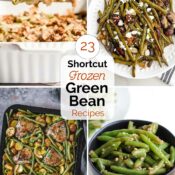
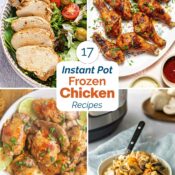

I was wondering if frozen cooked and smoked meat; such as a smoked turkey could be put in the crockpot, while it was still frozen.
That’s a great question, Cindi! I rarely work with smoked meats, and I’m not comfortable advising you on how that would affect the food safety aspects you’re asking about, regarding whether it’s safe to use frozen meat in the slow cooker if it’s already smoked. Just to be sure, I’d advise you to check in with the USDA Meat and Poultry Hotline about those nuances, and whether or not the fact that the meat was already smoked would make a difference for you. You can contact them toll free at 1-888-MPHotline (1-888-674-6854) – they’ve always been super-helpful when I have a question. Thanks, and good luck! ~Shelley
Uh-Oh! I need help!
I looked this up after creating a fabulous crockpot dinner for tonight. Its all set and already started cooking. WHAT DO I DO NOW?! I don’t want to throw it all away 🙁
Hi Catherine! I absolutely apologize that I am just now reading your comment. We were away last week on a big, extended family vacation, and for once I actually stepped away from comments, etc. for a few days. I’m really sorry that I wasn’t there to help you out. I hope everything turned out all right for you. ~Shelley
This question was asked awhile back and not answered: if you’re cooking the meat anyway to a temp that kills any bacteria anyway, what difference does it make??
Hi Jen! Great question! As we replied to Richard’s inquiry, beyond simply killing any bacterial growth (and you’d have to be sure that all of the meat was actually cooked to an appropriate temp, not just part of it), there’s a deeper issue with the harmful toxins produced by certain types of bacteria, not all of which are killed by the temperatures that kill the bacteria themselves. Again, the exact science of it is far, far beyond the scope of this article, but the experts at the USDA Meat and Poultry Hotline would be a great resource for you. You can call them toll free at 1-888-MPHotline (1-888-674-6854). Thanks so much for popping by today! ~Shelley
If you prefer to use microwave to defrost your chicken meat, then make sure not to put too many chicken meat pieces inside of your microwave.
Thanks for that suggestion! I totally agree, specifically because, when defrosting meat like frozen chicken breasts, putting too many in the microwave at once can lead to some of them cooking partway through and even beginning to get overcooked and tough while parts of others remain frozen. To help with this, I also usually microwave-defrost frozen chicken breasts in small time increments, rotating them throughout the defrosting time so they defrost more evenly. It’s really about the quality of the chicken at the end of the microwave defrosting time – and having chicken in which portions are overcooked and dried out already, just isn’t very appealing, is it?!? Thanks again for stopping by, and for offering the great suggestion! ~Shelley
There is a lot of misinformation contained in this post, and most of it is made possible by omission. The article isn’t wrong that food (meats especially) left at 40-140deg F will develop bacterial colonies at rapid rates, but an important detail is ommitted. This same thing happens as your meats are prepared, especially if the meat is ground. So why don’t you get sick?
Well, the reason 40-140deg is called the “danger zone” is that many live bacteria varieties grow quite comfortably in that range. Below that range, they tend to slow down. At freezing, most bacterial cells go dormant. Freezing meat doesn’t kill bacteria that are already there. It just stops them from reproducing as quickly.
When you cook food, though, you raise it above the 140deg ceiling. Many of you have probably read lots of meat cooling tips that say to use a meat thermometer and ensure the center of your cut is at least 160 or so degrees. The reason for this is that 160 degrees is a temperature that reliably kills bacteria. It doesn’t slow it down or put it to sleep. It kills it.
A Crock Pot cooks food by raising the temperature internally to roughly 180 to 200 degrees, depending on your model. It holds food at that temperature for an extended time so it can heat evenly, killing bacterial growth with the heat. This will happen no matter how much bacterial growth has occurred, provided you let the pot cook long enough to bring the temperature up throughout the *whole* cut. This will take longer with a frozen cut because the cut is dense. If you cook with frozen food and leave it in the pot for 8-10 hours (depending on your pot model) or more, you’ll likely be ok. You can test the meat with a meat thermometer just like you do when roasting. If it holds at 160+ for an hour, you will almost definitely be totally fine. That’s enough heat and time to kill whatever is alive in there. This works especially effectively if your frozen meat is surrounded by liquid. And the larger your piece of meat, the longer cooking will take. Use a thermometer to check both internal temperature and the temperature of exposed food surfaces!
But it does take longer to cook frozen food, no matter your method of cooking. You can cook frozen food just fine using almost any cooking method if you understand that heat kills bacteria and work with a thermometer to ensure proper heat levels.
Thank you for adding this–I think common sense should apply, and people shouldn’t be afraid to cook from frozen if it’s not a freakishly warm day and the cooker is set to a high enough temperature, for long enough, to kill the bacteria. This article puts the Fear Of God into people, unnecessarily–hurrah for science.
Hi, Mathilde! We apologize if we scared you – we actually tried to make our article about as friendly and non-scary as we could, while still answering an excellent question posed by a reader, regarding whether we use frozen chicken in a recipe. Knowing what we do about safe food handling, we can’t, in good conscience, recommend it, and we wanted to give readers some information and resources we thought they’d find helpful. Of course, what each person chooses to do with respect to food sanitation in their own kitchens – regarding frozen meat or any other sanitation issue – is definitely up to them. As we suggested to Richard, if you’d like to delve more deeply into the science behind the issue, you might call the USDA Meat and Poultry Hotline at 1-888-MPHotline (1-888-674-6854). They can go into more detail with you if you’re interested, and they’ve been friendly and tremendously helpful to us when we’ve had questions. Thanks so much! ~G&S
The article says cooking meat in a slow cooker is risky. Your reply here says not to be scared. Does increasing the slow cooking time for frozen meat eliminate the risk or not? And, no, I don’t want to call the hotline.
Hi Stourley – the short answer is that increasing the cooking time is not considered to be a safeguard that eliminates the risk. Thanks for the great question! ~Shelley
Thanks, Shelley! I am also informed by the USDA that “It is safe to cook foods from the frozen state. The cooking will take approximately 50% longer than the recommended time for fully thawed or fresh meat and poultry.”:
http://www.fsis.usda.gov/wps/portal/fsis/topics/food-safety-education/get-answers/food-safety-fact-sheets/safe-food-handling/the-big-thaw-safe-defrosting-methods-for-consumers/bigthaw2
Hi again, Stourley! These are great questions about frozen meat safety, and I know it can all seem pretty confusing. And you’re exactly right – the portion of the USDA’s site that you quoted does seem to be in direct conflict with the USDA’s other statement (that it isn’t safe to cook frozen meat in the slow cooker). So, I called the USDA’s hotline (the one we list above – 1-888-MPHOTLINE) for you, and asked them to clarify, in their own words, why those two statements seem to be in conflict. I spoke with a very helpful Food Safety Specialist named Claire, who explained that the document you’re mentioning (the one entitled “The Big Thaw — Safe Defrosting Methods for Consumers”) is NOT intended to address slow cookers, and that’s why they created the separate document (which we reference above – the one entitled Slow Cookers and Food Safety at http://www.fsis.usda.gov/wps/wcm/connect/a181017c-cc51-4261-bfeb-f78cfc24c022/Slow_Cookers_and_Food_Safety.pdf?MOD=AJPERES). The USDA intended “The Big Thaw” document you were reading to pertain to cooking on the stovetop or in the oven. It would definitely help clarify things a bit if their document stated that, though – I definitely agree! At any rate, I hope my discussion with Claire helps you understand the differences better and sheds some light on why those two statements seem to be in direct conflict with each other. Thanks again! And although I know you said you didn’t want to call the hotline yourself, I really do recommend it if you still have questions or would like to discuss all of these nuances in greater detail with a Food Safety Specialist. ~Shelley
Hi there, Richard! There is definitely a lot more to the story here – people make entire careers out of studying microbiology, bacteriology and food safety. The deeper issue has more to do with the harmful toxins produced by certain types of bacteria, not all of which are killed by the temperatures that kill the bacteria themselves. The exact science of it is far, far beyond the scope of this article, but the experts at the USDA Meat and Poultry Hotline would be a great resource for you. You can call them toll free at 1-888-MPHotline (1-888-674-6854). Thanks so much for adding your thoughts to this great conversation! ~G&S
I have been cooking frozen pot roast in a crock pot (low setting for 10 hours) for over 40 years (or you can cook it at 250 in an oven wrapped tightly in aluminum foil). I have never ONCE gotten sick and the meat always comes out super tender, succulent — falling part! When I take the meat out of the crock pot, the juices are simmering and the meat is completely cooked and flakes apart. It melts in your mouth. I vary the recipe from time to time but generally this is what I do: I put in the pot roast, then whisk 1 can of cream of mushroom soup with 1 soup can of filtered water and 1 packet of Lipton French Onion soup mix – and pour this all over the roast. I grind a healthy amount of fresh ground pepper (a tblsp. is good), a tblsp. of sea salt, 3 sprigs of fresh thyme and 2 fresh bay leaves (tuck the bay leaves under the roast). Add a carton of thoroughly washed button mushrooms (keep them whole so they will burst with flavorful juice when you bite into them – yummy!), 6 small red or gold potatoes, 4-5 organic carrots cut into 3 pieces each (I love carrots in a pot roast), 8-10 organic brussel sprouts (you can substitute peas or whole green beans if you don’t like them). My mother was from New England and always added a peeled, diced turnip (optional). Make sure the veggies are submerged in the liquid as much as possible. You can add a little wine if you like too but not necessary (if you do add wine, cut back on salt). Or, you can cook your roast like this at 250 in your oven. Make sure you cover the roast pan tightly with aluminum foil. I love coming home to the smells of pot roast waiting! All you have to do is throw your favorite rolls in oven or make some cornbread 9serve with butter and honey) to go with it. It’s good to treat yourself and your family to a nice home cooked “comfort” meal on a work night. Nothing is easier than pot roast and you can safely cook it this way. Just cook it long enough and, before serving, cut in center to test doneness or use a cooking thermometer in center of meat to see if it registers at 165). I worked in food service for several years and received extensive training on food borne illnesses, etc. You will not get sick cooking meat from frozen if you follow these simple instructions. In fact, I cooked a 3 lb. angus pot roast on Friday this way and it was absolutely succulent with a texture like filet mignon (LOW setting in crockpot for 10 hours). Meat is so much more tender when cooked from frozen. I’ve done this with all cuts of meat – chicken, beef, pork (Boston butt is phenomenal cooked this way) – doesn’t matter. Just use a cooking thermometer and enjoy!